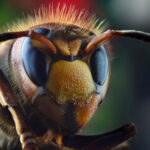One kind of solitary bee that usually builds its homes in wood is the carpenter bee. Carpenter bees do not reside in hives or colonies like honey bees do. Rather, every female carpenter bee builds her own unique nest. You might have carpenter bees if you’ve ever noticed a perfectly round ½-inch hole in your deck, patio furniture, mailbox post, children’s playset, or even your home’s cedar siding. A hint of coarse sawdust on the surface below the hole is another suspicious clue.
The Xylocopa virginica, or carpenter bee, is a very remarkable insect. They are non-aggressive native pollinators. The woman is just a single mother looking after her children. Because of their similar appearance, people often confuse carpenter bees and bumble bees. A carpenter bee, measuring between ¾ and 1 inch in length, makes its home in wood-excavated tunnels. You can easily distinguish carpenter bees from bumblebees by their hairless abdomens. Bumble bees build their underground nests and have fuzzy backs. Bumble bees do not drill into your home.
Table of contents
Do carpenter Bees sting?
Carpenter bee males are incapable of stinging because they lack stingers. They are not harmful when it comes to stinging, but they are frequently more aggressive and possessive.
Conversely, female carpenter bees do have stingers. They are generally peaceful animals and do not sting unless provoked or in danger. Rather than vigorously guarding their nests, female carpenter bees are more concerned with building their nests and gathering pollen. Even though bee stings are uncommon, you should always proceed with caution when around bees to prevent potential stings, particularly if you are allergic to their venom.
It is preferable to stay away from carpenter bees and not disrupt their nests to keep yourself safe from their sting. For effective and secure removal techniques, please speak with a pest control expert if you need to deal with a carpenter bee infestation close to your house.

Why do carpenter Bees drill holes?
Carpenter bees drill holes or bore into wood primarily for nesting purposes. Carpenter bee holes are different from termite holes. The drilling behavior is part of their reproductive cycle and is linked to the creation of individual nests for their offspring. Carpenter bee drilling is a normal aspect of their reproductive cycle, but it can cause structural damage to wooden furniture, buildings, and other items. If their actions are a concern, take suitable steps to minimize potential harm while honoring the ecological significance of these pollinators. Examples of these steps include painting or staining wood surfaces and hiring a pest management company.
The good news is that carpenter bee seldom cause significant harm and are typically only an annoyance. Sometimes, years of continuous drilling can cause issues when the holes allow moisture to seep in and cause rot.

How to get rid of carpenter bees?
There are a few steps you may take to stop carpenter bees from boring holes in the wooden structures surrounding your house. Remember that these bees are crucial pollinators, thus it’s usually preferable to employ preventive measures that deter bees from building nests without endangering them. Here are some ways you can get rid of them:

Paint wood surfaces
Unfinished or untreated wood attracts carpenter bees. Paint or stain wood surfaces to keep carpenter bee from nesting. To guarantee longevity and efficacy, use exterior-grade paint or stain of the highest caliber.
Apply insecticides
Applying pesticides to wood is a possibility, but it’s crucial to use those with labels that expressly address carpenter bee control. Administer pesticides onto the wood’s surface, paying close attention to the manufacturer’s recommendations.
Fill existing holes
If carpenter bee holes are visible, seal them with wood putty or an appropriate filler. Blocking holes during the bees’ active season may trap larvae inside, so be careful to do this in the late fall or winter when the bees are not busy.
Hang carpenter bee traps
Use commercially available carpenter bee traps to attract and contain them. Set up these traps close to carpenter bee activity regions. For optimal use, refer to the instructions that come with the traps.
Use natural deterrents
Natural deterrents could come from planting some scented plants close to timber structures, including marigolds, mint, or citronella. To keep carpenter bees away from wooden surfaces, apply essential oils such as citrus or tea tree oil.
Create loud noise
Since carpenter bees prefer stillness, place a radio or speaker close to or atop the nest site if you find yourself hosting some unwanted visitors. They will leave their nest due to the vibrations and the music’s ability to disorient them. Frequently, if a serious issue arises in their nest, they will no longer go back there.
Boric Acid
This everyday home item can be utilized for a variety of do-it-yourself bug elimination operations. Utilizing a spray bottle, combine three parts water and one part boric acid, then mist into the opening. Within one hour, this will destroy the carpenter bee due to its extreme toxicity.
Consult a professional
Seek advice from a pest management expert if there are significant or ongoing carpenter bee infestations. To reduce carpenter bee activity, experts can evaluate the situation and administer focused remedies.
Keep in mind that carpenter bees are helpful pollinators, so it’s usually preferable to employ preventative techniques that don’t kill them. For safe and responsible carpenter bee management, always use insecticides in accordance with safety precautions and think about speaking with a pest control expert.
Can I seal the holes left by carpenter bees?
One successful strategy to deter repeated nesting is this one. Treat the entry holes of tunnels that are easily accessible. Apply a substance designated for carpenter bees to the tunnel entrance. After a few days, leave the holes unplugged and fill them with wood putty, caulking, or wood glue and a wooden dowel. The bees can chew their way out of the hole if you don’t treat it. Additionally, sealing the gaps helps stop wood rot and moisture ingress.
However, contact a professional pest control firm if you have a large-scale issue, such as several carpenter bee drilling into the wood exterior of your home, woodpeckers looking for an easy meal, or holes that are high above the ground and require the use of a ladder. According to Delaplane, the business should treat each hole to make sure there are no repeat visitors.

Frequently asked questions (FAQs) about getting rid of carpenter bees
Q1. How do you permanently get rid of carpenter bees?
8 quick ways that can help you get rid of carpenter bees:
- Any exposed wood in your home should be painted or sealed.
- Use a vacuum cleaner if the nest is new
- Create loud noise near their nest
- Use citrus spray
- Use essential oils, their scents deter them away
- Use pyrethrum spray which is made from a flower, it is a strong insecticide
- Use a mixture of boric acid and water
- Use aerosol carburetor cleaner
Q2. What naturally kills carpenter bees?
To get rid of Carpenter bees put garlic powder right into their holes. Garlic powder works much better. Consider using Boracare as a long-term solution for your carpenter bee goods if the region is unfinished or unpainted.
Q3. What smell do carpenter bees hate?
Combine jojoba, citronella, tea tree, and lavender oils; transfer the mixture to a spray bottle. Carpenter bees are repelled by this potent combination. Douse it on the area surrounding the nest and the bees’ preferred hangouts.
Q4. What attracts carpenter bees?
Flowers attract carpenter bees much like other bees do. These bees will probably be interacting with other pollinators such as butterflies and bumblebees if your yard is overflowing with flowers. Untreated wood also attracts carpenter bee, which is useful for making wood cladding, decks, sheds, and fences.
Q5. Does vinegar attract carpenter bees?
A common natural carpenter bee deterrent is a mixture of vinegar and aromatic oils. Apply this mixture anywhere carpenter bees construct their nests and burrow into wood buildings, such as porches and decks.
Q6. What is the best homemade bee killer?
In a spray bottle, combine one part dish soap with four parts water. Apply this solution to all bees. Unlike insecticides, the soap-water solution kills the bees without leaving a toxic trace behind. Until no bees return for at least a day, spray every bee. Visit our blog for other interesting insect-related articles.




